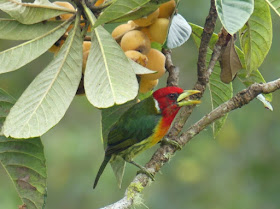I had long wanted to see something of Central America, and in particular Costa Rica, and very recently we had the opportunity to do so in the form of a reconnaissance trip preparatory to taking a group there next year. As well as our long-term friend and tour organiser extraordinary, Peruvian Juan Cardenas, we had the company and remarkable knowledge and skills of local guide Leo Garrigues.
For now I just want to offer a very brief overview of this remarkable
little country with an introduction to some of its habitats and birds
today, to be followed up next time with a selection of some of its other
spectacular wildlife.
 |
| Montane Rainforest from above; Canopy Walk at Monteverde, northern Pacific slopes. (a) See map for locations of photos, using the letters at the end of each caption. |
Costa Rica is tiny, just 50,000 square kilometres (about 75% of the size
of Tasmania, for my Australian readers) with a population of five
million. It is bordered by Nicaragua to the north, Panama to the south,
the Pacific Ocean to the west and the Caribbean to the east. A spine of
mountains from north to south divides it.
 |
| The letters on the map refer to the locations of the habitat photos above and below; letters follow captions. (Approximate only.) |
It is fairly well-known that Costa Rica dissolved its army 70 years ago
after a brief six week civil war; since then it has known only peace and
prosperity. Moreover it has a refreshingly responsible approach to
social and environmental issues which most wealthy countries should be
embarrassed by. For instance its education budget is 7% of its total expenditure,
compared with a world average of roughly 4.5%. (The most recent
Australian figure I can find is 5.9%.)
Remarkably it is seemingly the only country to meet all five of the
United Nations Development Program criteria for measuring environmental
sustainability. We were constantly struck by just how much forest
remains, with regeneration programs to supplement this. By 2016 98% of
its energy was produced by renewables, with a goal of being nationally
carbon neutral in the near future. And for a visitor, the infrastructure
for nature-based tourism is just superb!
Nowhere is perfect of course, but few of us come from a
country which could look down on Costa Rica’s aspirations and
achievements. I certainly don’t come from such a one.
Here is a sample of the range of habitats we enjoyed in our stay,
 |
| Primary Lowland Rainforest, La Selva Biological Station, Caribbean Lowlands. (b) |
 |
| Cloud Forest, Talamanca Mountains, southern Pacific Slopes. (c) |
 |
| Wetlands, Medio Queso, near the Nicaraguan border. (d) |
 |
| Parramo heath vegetation, 3400 metres above sea level, southern Pacific slopes. (e) |
 |
| Mangroves, Puerto Morales, Pacific coast. (f) |
And with that, please meet some of the more than 300 birds species we saw (in just 9 days of travelling!) that lived there and particularly impressed us. Perhaps we should start with one of the most famed and sought-after birds of Costa Rica.
 |
| Resplendent Quetzal female; a small flock of these amazing birds were feeding on fruit in this tree early on our very first morning in the country! |
 |
| Collared Aracari Pteroglossus torquatus, in a private garden in the Central Valley north of the capital San José. This one is found from southern Mexico to Ecuador. |
 |
| Pale-billed Woodpecker Campephilus guatemalensis, Carara NP, near the Pacific coast north of San José. A big Central American woodpecker. |
 |
| White-throated Magpie-Jay Calocitta formosa, western Central Valley. A dramatic big jay, one of the crow family, noisy, gregarious and eating almost anything. |
 |
| Least Bittern Ixobrychus exilis, indeed one of the world's smallest herons (less than 35cm long and weighing less than 100 grams) and usually notoriously hard to see. Not this one! |
 |
| Yellow-breasted Crake Porzana flaviventer, fairly widespread but like most crakes usually a skulker. |
And tanagers and hummingbirds are always going to earn a place on any list of special Latin American birds - Costa Rica is certainly no exception here.
 |
| Crimson-collared Tanager Ramphocelus sanguinolentus, Mariposaria private garden, Caribbean slopes. Another bird limited to Central America. |
But just before we go, I really should acknowledge the Costa Rican national bird, given that we've met representatives of three other Central American countries. It seems somehow appropriate that this bird is not spectacular or rare at all, rather it is plain-coloured and ubiquitous, perhaps a bird of the people. Here in fact is a whole patriotic feeder tray of them.
 |
| Clay-coloured Thrushes Turdus grayi, La Fortuna; the national bird of Costa Rica! |
Costa Rica is truly wonderful. I hope you can join me next time to celebrate some of its other animals.
NEXT POSTING THURSDAY 26 SEPTEMBER
(And remember that you can get a reminder when the next post appears by putting your email address in the Follow by Email box in the top right of this screen.
And I'd love to receive your comments - it's easy and you don't need to sign in!)
(And remember that you can get a reminder when the next post appears by putting your email address in the Follow by Email box in the top right of this screen.
And I'd love to receive your comments - it's easy and you don't need to sign in!)









Beautiful, Ian. Your writing takes me there.
ReplyDeleteThank you Margie - you should take yourself there! (But meantime, enjoy Japan.)
ReplyDelete